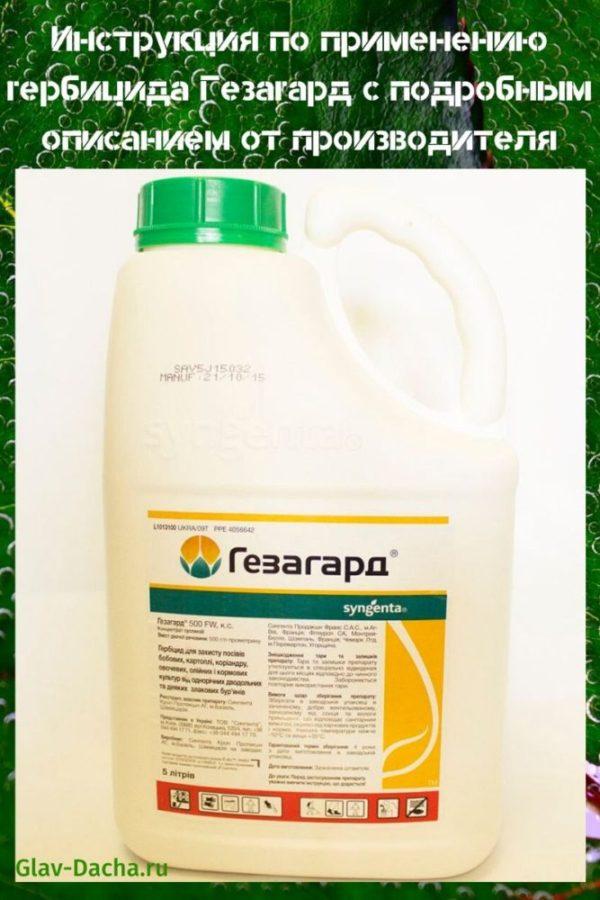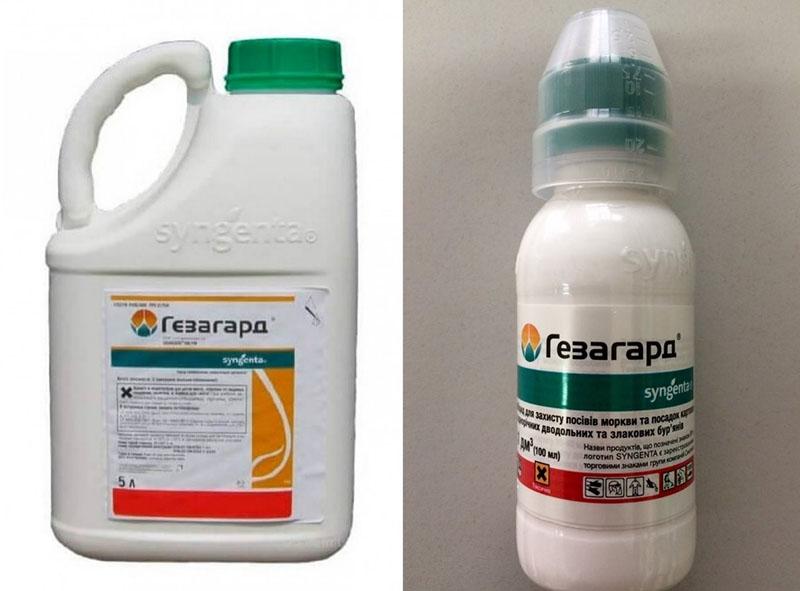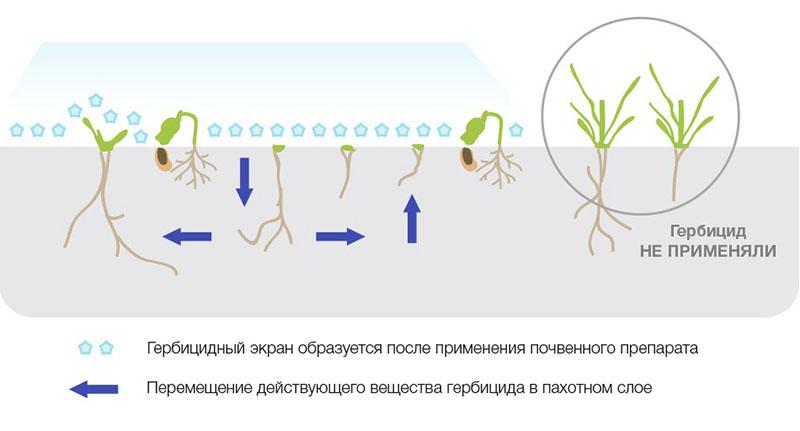Instructions for the use of the herbicide Gezagard with a detailed description from the manufacturer
 You can fight weeds not only with a hoe, but also with the assistance of potent herbicides. Detailed instructions on the use of Gezagard will be a real find for a hardworking farmer. The concentrated preparation has a long-term protective effect. Subject to the regulations, the product is not toxic to crops, bees and humans. The chemical copes excellently with annual dicotyledonous and cereal weeds.
You can fight weeds not only with a hoe, but also with the assistance of potent herbicides. Detailed instructions on the use of Gezagard will be a real find for a hardworking farmer. The concentrated preparation has a long-term protective effect. Subject to the regulations, the product is not toxic to crops, bees and humans. The chemical copes excellently with annual dicotyledonous and cereal weeds.
Prometrin - active ingredient of the herbicide

Prometrine bonds accumulate upon contact with vegetation and begin:
- hinder the course of the photosynthesis process;
- block the passage of Hill's reaction;
- form compounds that destroy the membranes of weed cells.
 Since the herbicidal concentrate is used before germination, the main component acts both on the roots of the germinated seeds and on the sprouts. Gezagard is equally absorbed not only by the leaves, but also by the rhizomes of the culture. The chemical remains in the soil for 4-10 weeks. The increased activity of prometrine is observed within 30-45 days after application. In reaction with weeds the chemical composition enters the first 2-4 days after the emergence of shoots. After 7-12 days, the weeds die completely.
Since the herbicidal concentrate is used before germination, the main component acts both on the roots of the germinated seeds and on the sprouts. Gezagard is equally absorbed not only by the leaves, but also by the rhizomes of the culture. The chemical remains in the soil for 4-10 weeks. The increased activity of prometrine is observed within 30-45 days after application. In reaction with weeds the chemical composition enters the first 2-4 days after the emergence of shoots. After 7-12 days, the weeds die completely.
Maximum herbicide efficacy has been tested on annuals such as:
- highlander;
- Mary white;
- amaranth;
- nightshade (black);
- field mustard;
- chicken millet;
- bristle;
- quinoa (spreading and garden);
- wood lice;
- purslane;
- shepherd's bag;
- piculnik;
- walker;
- smoky medicine.

The duration of the protective effect of the herbicidal agent is determined by climatic conditions, as well as the type of soil and the rate of consumption of the drug.
However, Gezagard is not able to destroy all the weeds that grow in the garden or field. The varieties of veronica, ragweed, nettle, bindweed, prickly nightshade and pickleberry (chaffinch) were less sensitive to prometrine. Umbelliferae, cruciferous and labiate species, as well as some varieties of pickleberry and bedstraw, have shown resistance to the herbicide.
Instructions for using Gezagard on your garden plot
 The active component of the pesticide has a unique ability to "stick" to organic and clay soil elements. The decomposition period of prometrine (microbiologically) lasts from 14 to 158 days. The average decomposition time of a chemical in soil is 50 days.
The active component of the pesticide has a unique ability to "stick" to organic and clay soil elements. The decomposition period of prometrine (microbiologically) lasts from 14 to 158 days. The average decomposition time of a chemical in soil is 50 days.
The main method of application of the herbicide Gezagard is soil spraying:
- before the start of garden work;
- in the post-sowing period;
- before germination;
- in the phase of 2-4 full leaves (coriander, dill, carrots).

Manufacturers suggest using any of the options mentioned. Before starting the etching, carefully prepare the site. The surface is leveled, large clods of earth are broken up so that the soil acquires a fine lumpy (granular) structure.After loosening, the soil is abundantly moistened with settled water. The concentrate is not recommended to be embedded in the ground, so as not to reduce its effectiveness.
The herbicidal preparation should not be applied to the soil if the temperature is expected to drop in the near future. After the frost has passed, the procedure is planned for 2-3 days, so that the earth warms up a little.
Dosage of the drug and preparation of the working solution
 Depending on the degree of damage to the land plot by weeds, the rate of the herbicide is calculated. The percentage of humus in the soil also affects this indicator. For heavy types of soils, the maximum doses of the agent are used.
Depending on the degree of damage to the land plot by weeds, the rate of the herbicide is calculated. The percentage of humus in the soil also affects this indicator. For heavy types of soils, the maximum doses of the agent are used.
Thus, the Gezagard consumption rate for different crops is:
- for vegetable peas 2 l / ha;
- 2-3 l / ha for carrots, parsley, dill and celery;
- 2.5-3.5 l / ha for garlic (except for planting on a feather);
- for sunflower and corn 2-4 l / ha;
- 3-4 l / ha for potatoes and coriander;
- 3-5 l / ha for peas for grain and soybeans.
 Optimum temperature permissible during the event: + 15 ... + 20˚С. Under these conditions, prometrine is best at showing its herbicidal properties. The effect of Gezagard on dill and other cultivated crops is limited to only one season. In this regard, some farmers do not recommend sowing winter varieties of grain or perennial grasses in the fall. This is usually done the next year.
Optimum temperature permissible during the event: + 15 ... + 20˚С. Under these conditions, prometrine is best at showing its herbicidal properties. The effect of Gezagard on dill and other cultivated crops is limited to only one season. In this regard, some farmers do not recommend sowing winter varieties of grain or perennial grasses in the fall. This is usually done the next year.
The waiting time for the preparation for parsley root is 45 days. In all other cases, the given figure does not exceed 28-30 days.
Preparation of working solution
 The spray tank (10 L) is half filled with water. The required dosage of the herbicidal preparation is introduced. Mix thoroughly. As soon as the emulsion acquires the required homogeneity, bring the solution to full volume, stirring constantly. As shown in the instructions for use of Gezagard, 250-350 liters of working fluid are consumed per hectare of area. In case of severe damage, the volume is increased to 400 l / ha.
The spray tank (10 L) is half filled with water. The required dosage of the herbicidal preparation is introduced. Mix thoroughly. As soon as the emulsion acquires the required homogeneity, bring the solution to full volume, stirring constantly. As shown in the instructions for use of Gezagard, 250-350 liters of working fluid are consumed per hectare of area. In case of severe damage, the volume is increased to 400 l / ha.
Spraying is carried out in calm weather and with a freshly prepared solution. The working emulsion retains its effectiveness for 24 hours.
Gezagard compatibility, as well as its analogues
 Due to its unique action and composition, the drug is successfully mixed with other protective agents in this category.
Due to its unique action and composition, the drug is successfully mixed with other protective agents in this category.
For spraying peas, soybeans, potatoes and sunflowers in tandem with Gezagard use:
- Dual Gold;
- Coat of arms 900;
- Dialen Super;
- Corporal.

For this reason, the herbicide is often used to prepare tank mixes. Prometrile is excellently combined with alkaline and acidic compounds.
Nevertheless, some gardeners choose analogues of the Gesagard herbicide, among which:
- Hurricane Forte (Switzerland);
- Lontrel (USA);
- Fuselade;

- Basagran (Germany).
The listed herbicidal agents differ in the active substance. Because of this, the scope of these agents has been expanded to include many other varieties of weeds. This is evidenced by the instruction for the use of Gezagard. Nevertheless, the result of the pickling depends largely on the climatic conditions of the area and the characteristics of the soil.